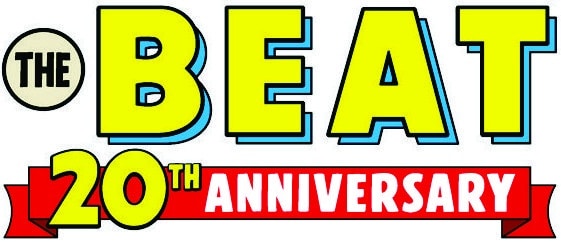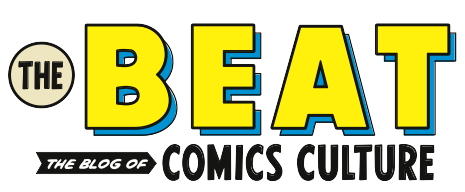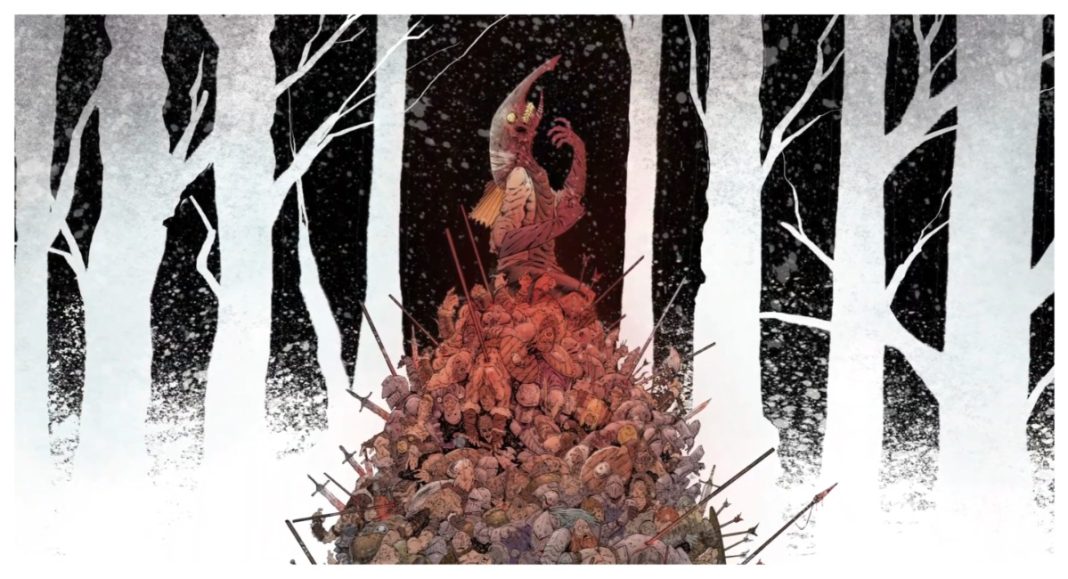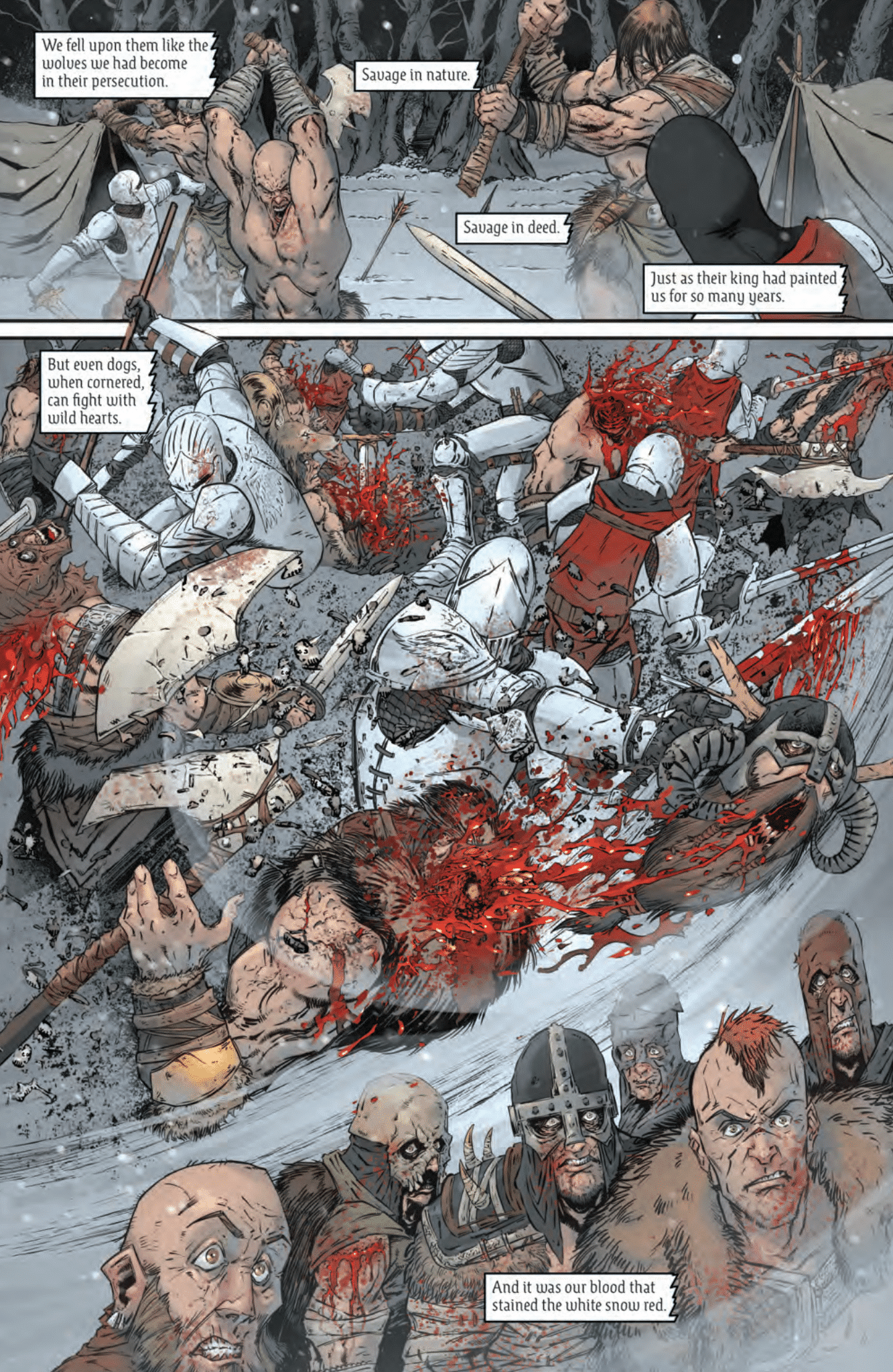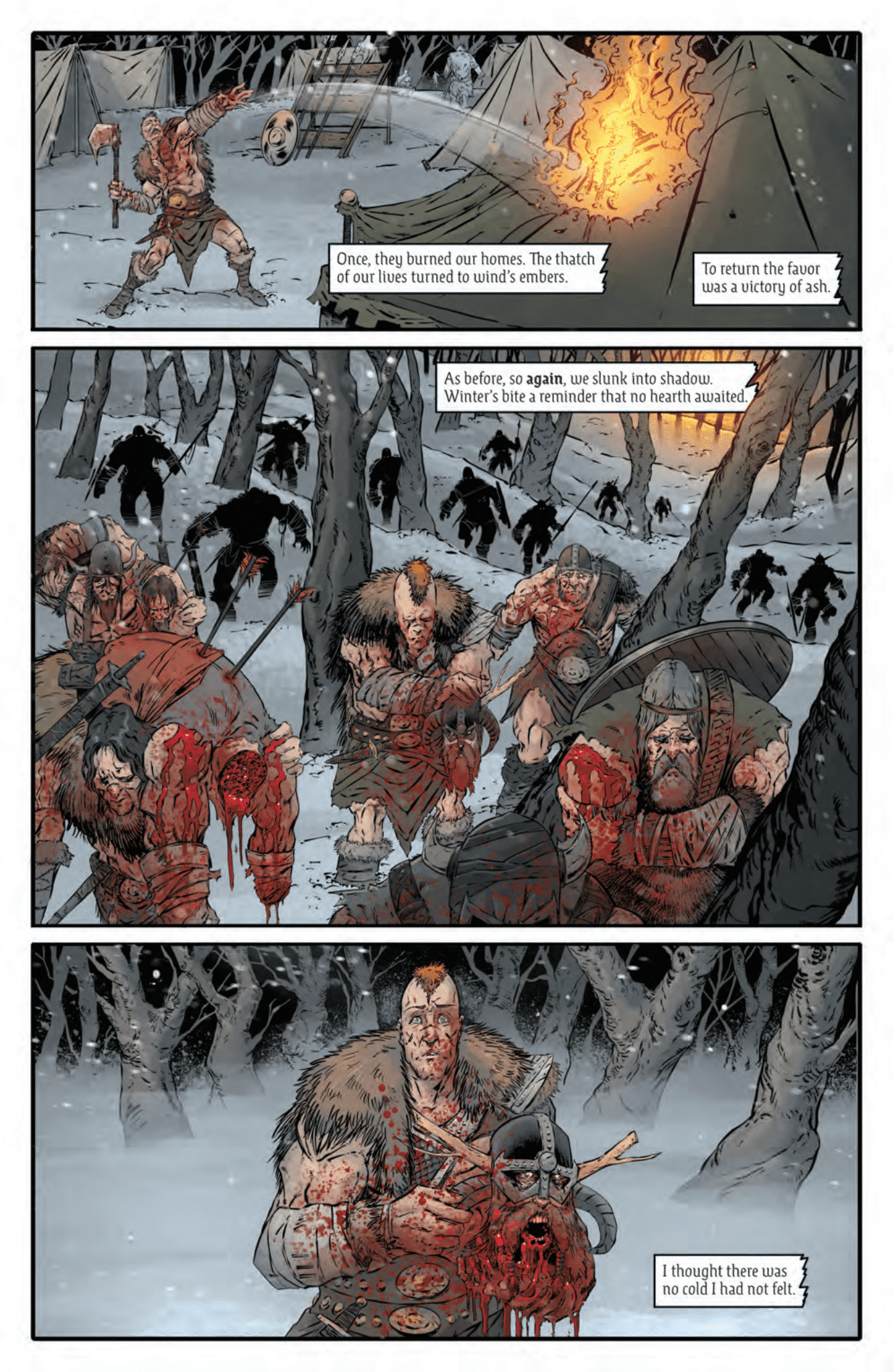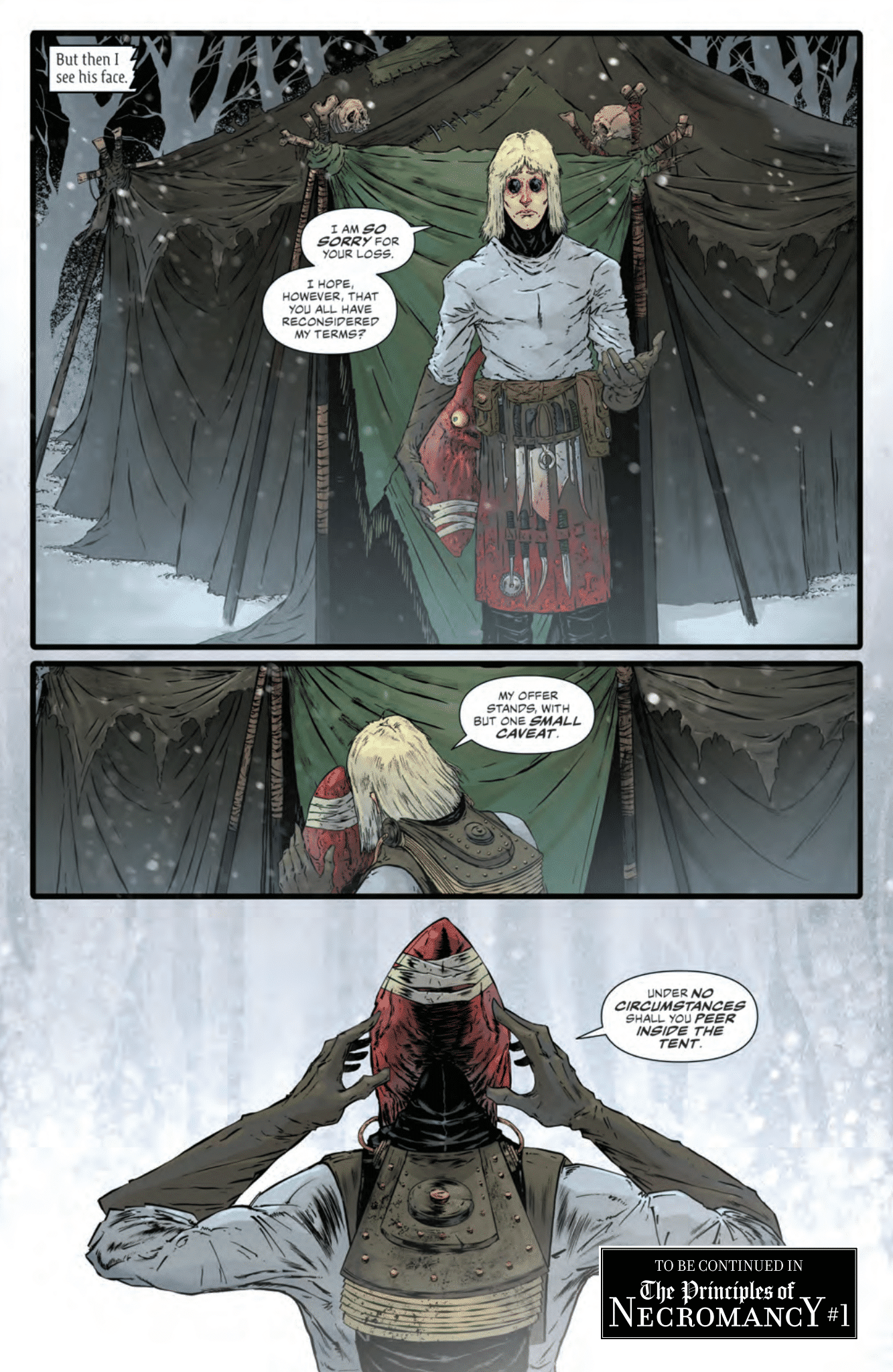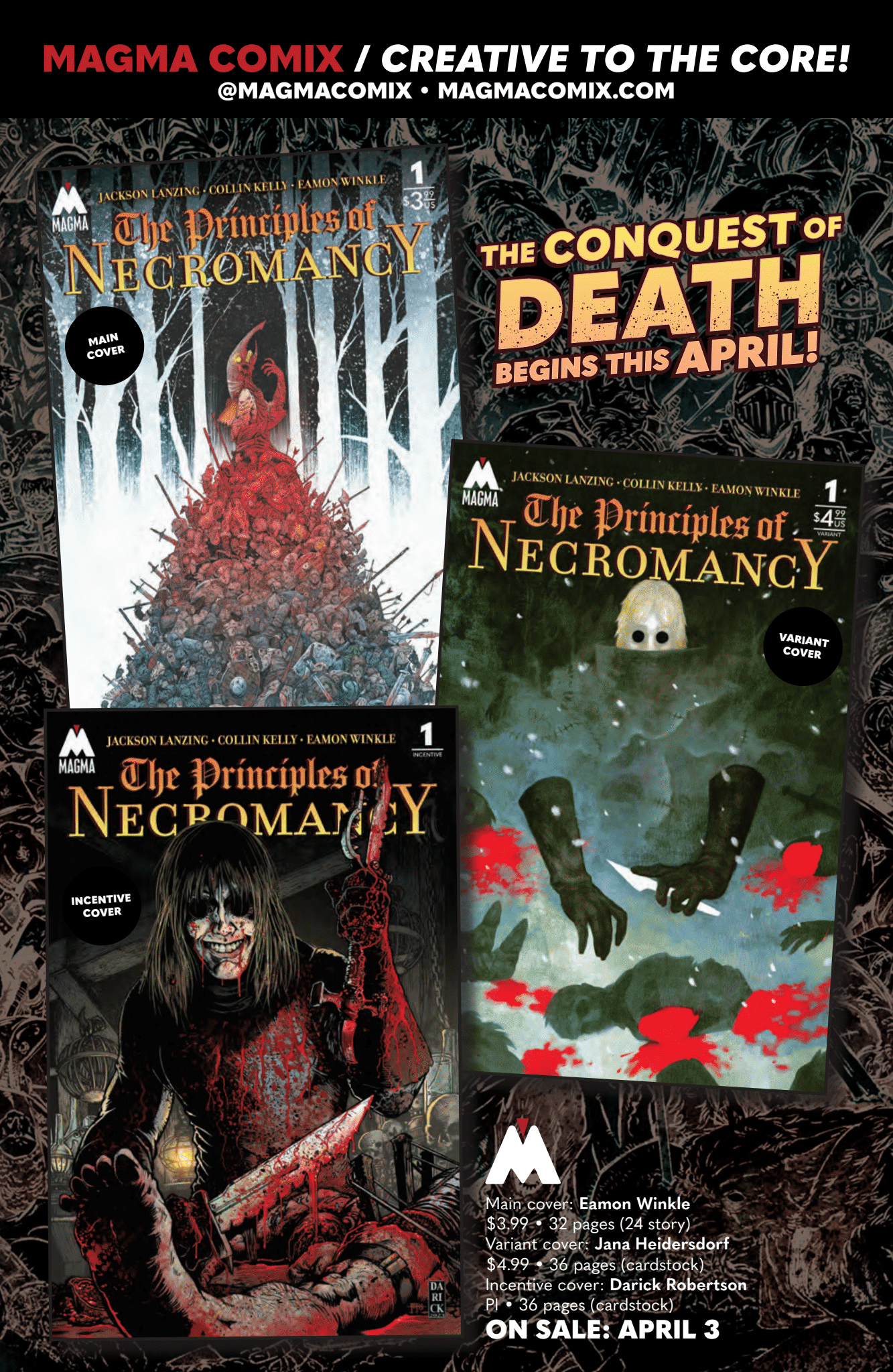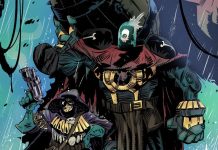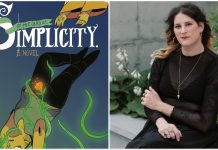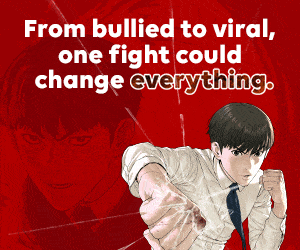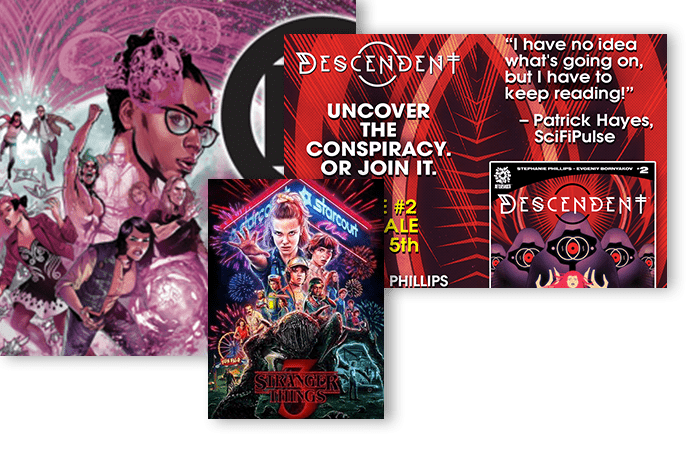Writers and co-creators Collin Kelley and Jackson Lanzing (Outsiders, Guardians of the Galaxy, Star Trek) team up with Eisner-nominated artist Eamon Winkle to bring to life The Principles of Necromancy.
While brave knights and dangerous monsters wage endless war, business is booming for Dr. Jakob Eyes, a traveling physician whose arcane remedies are the closest thing to magic the world knows. These gruesome miracles are only stepping stones for Dr. Eyes’ ultimate ungodly goal: to overcome death itself.
The Beat wanted to learn more about the project, and reached out to the creators over email for an interview!
DIEGO HIGUERA: The Principles of Necromancy features a unique character in Dr. Jakob Eyes. What was the inspiration behind creating a physician with such a macabre goal of overcoming death?
COLLIN KELLY: The inspiration for Dr. Eyes came hand in hand with the world we wanted to explore: a high fantasy setting, but one without magic. Steeped in harsh truth, there was no one we imagined to be more suited to explore its secrets than a scientist, and there is no science greater – or more “noble” – than that of the physician. When we realized what that meant – that here, Doctors were considered Wizards, to be feared and idolized in equal measure – the character of Eyes, youngest of them all, began to take shape.
JACKSON LANZING: It’s a direct reflection of ideas as old as the genre itself. Eyes is a twist on the now-classic Victor Frankenstein archetype – a scientist who seeks the limits of science. But why? For ambition? For personal gain? For revenge? Or is it something deeper? Who is this man behind the mask? That’s the question every issue of The Principles of Necromancy is designed to ask – as we see Doctor Eyes from every perspective except his own and ask the reader to make up their own mind.
EAMON WINKLE: As far as the physical design of the character, the thing that really made it “click” was the agreement “he cannot look like a villain”. Eyes needed to look approachable, innocent even, because at his core he’s doing the world a great service by trying to save them from death. So we have this angelic-faced guy who’s doing what he can to help people. It just so happens his idea of “helping” can lead to some places you don’t want to go…
HIGUERA: Jackson and Collin, you’ve collaborated on several high-profile series like Guardians of the Galaxy and Star Trek. How does working on a creator-owned project like The Principles of Necromancy differ from writing for larger franchises?
LANZING: In short: we don’t answer to anyone but ourselves. Big properties are amazing, but they come with an understandable concern for things like sales, “the health of the brand” and such. We’ve been lucky enough to gain an understanding of how to work in those systems, but truthfully, it’s always a delicate balance that starts with pure, experimental creativity at a disadvantage. That’s not true of The Principles of Necromancy. Here, we answer only to ourselves – and to whatever readership finds the story along the way.
KELLY: For me at least, the big change is that the guardrails of continuity are off. You can’t build off what has come before, because literally nothing has come before. This can be absolutely freeing, but there is an uncertainty that comes with it as well – you’re unable to rely on the love of known characters, you have to put out the most authentic story you can, and simply pray that your unique vision resonates with the audience, and finds the people who will love your strange child as much as you do.
HIGUERA: Eamon, your art has been described as evocatively horrific. Can you tell us about your process for bringing the dark, grim world of The Principles of Necromancy
to life?
WINKLE: How kind! While I love drawing a little of everything, the horror genre has always been a place of comfort for me, so I felt right at home working on Necromancy. There’s a lot of collaboration in the process of the book; we have weekly meetings where we go over the script and brainstorm everything from page layouts to character designs, to the final artwork. It never feels like work, it just feels like three friends having fun. And let me tell you, it’s tons of fun bringing Doctor Eyes and his world to life.
HIGUERA: The world of The Principles of Necromancy blends elements of high fantasy with dark, arcane magic. How did you approach world-building for this series, and what were some of the key influences behind it?
KELLY: First, let’s change that “dark, arcane magic” with “twisted, forbidden science”…that really is the core of our world-building. We centered it all around the concept of how we can take things that would normally be considered magic, and turn it into something “practical” (and yes, we understand that “practical” in this context is a stretch). Tonally, we took strong influence from things like LotR, Conan, and Elden Ring, while always remembering a little Mike Mignola over our shoulders, channeling Hellboy’s shadows and supremely human storytelling, even in the fact of the eldritch impossible.
LANZING: Exactly. In this world, there’s no such thing as magic. There’s just what we can do with our own two hands… and that’s horror enough.
HIGUERA: Dr. Jakob Eyes’ arcane remedies and gruesome miracles are central to the story. How do you balance the horror elements with character development to keep readers engaged?
LANZING: The center of every story Collin and I tell is character – it’s where we start, first and foremost. The giant corpse-golem at the end of The Principles of Necromancy #1 wasn’t the pitch – Kairn’s journey from “honorable warrior” to “horrified immortal” was. The same is true for Eloise in issue #2, Doctor Mind in issue #3, and the City King in issue #4. Each had their own journey to go on – and their own aspect of Doctor Eyes to reveal – and so the horror becomes the thing we can all deploy tactically to turn the screws on those arcs and make them as primal as possible.
KELLY: Fortunately, when it comes to horror, Eamon is a new master of the form. So our tame imaginings become something really different in his hands – and even as the writers of the book, we end up going home with nightmares.
WINKLE: With body horror, which we play with a lot in this book, the horror to me comes from not only the visuals that you see but the connection to the character as well. It’s that connection to the characters we follow is the essential element in creating horror. With Kairn for example, we see his love for his brethren, his devotion to his king, and it’s that love and desperation to save them that leads him to accept Eyes’ offer of help, which leads to his eventual fate as a human rat- king. So while his new form is visually horrific, it’s also the knowledge that he had a hand in his own ruin is equally (if not more) terrifying.
HIGUERA: Eamon, you were recently nominated for the Eisner Newcomer Award. Has this recognition influenced your approach to The Principles of Necromancy, and what did it mean for you personally?
WINKLE: Words (or drawings) cannot begin to describe how incredibly honored and grateful I am for the Russ Manning Eisner Nomination. Art and creating can at times be a very solitary thing, so getting that nomination was definitely a big neon sign saying “You’re doing something right, keep going!” and that encouraged me tenfold. And to receive the nomination because the work done on The Principles of Necromancy proved that we had something really special here, and I think that motivated us more.
HIGUERA: As creators who have worked on such diverse projects, what new opportunities did The Principles of Necromancy present for each of you creatively?
LANZING: This is our first foray into this kind of horror – and our first creator-owned issue-by-issue comic in nearly eight years – so the new opportunities are pretty evident. Freedom! Spooky stuff! Experimentation with the single-issue form – which is one of Collin and my favorite things to explore. That said, it also really allowed us to fuse some deeply-held fears about death and life into the pages of a strange fantasy world that worked only by our rules. That’s a joy in and of itself – as Collin mentioned earlier – to be crafting a world to fit the story, not the other way around.
KELLY: It’s an incredibly basic, visceral answer, but it’s the chance to write things that are TRULY DISGUSTING. Not just visually – though who doesn’t love the gorgeously gruesome glory of guts – but in terms of motivation. There is a character – we call him the “science asshole” – that is a staple of literature, but is very hard to emotionally connect to; Principles has been our chance to take that character, and do our best to make him into someone you might not like…but whom you want to see succeed.
WINKLE: Speaking of firsts, this is my first foray into comics! So this really was an entirely new opportunity for me, and I wanted to bring my A-game to every page to show what I could do. I wake up every day so thankful to Jackson and Collin for giving me the opportunity to join them on this book and create this wonderful, and oftentimes, terrifying world. It really is an absolute joy.
HIGUERA: Is there anything you want to share with readers and fans?
LANZING: Only our heartfelt thanks to every person who takes a chance on The Principles of Necromancy… and a promise that Doctor Eyes’ terrible journey is nowhere near complete. Keep your eyes peeled. Doctor’s orders.
WINKLE: To all the readers who picked up this book, all the comic shops and bookstores who carried it, to anyone who joined us on this ride, we thank you from the bottom of our hearts! My pencils are sharpened and ready to bring you more of the world of Principles of Necromancy!
